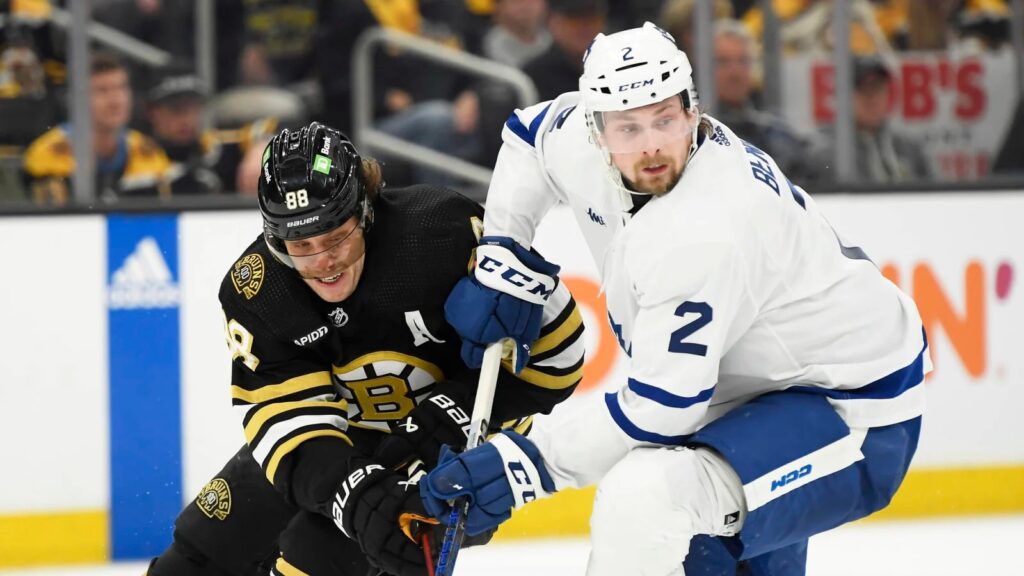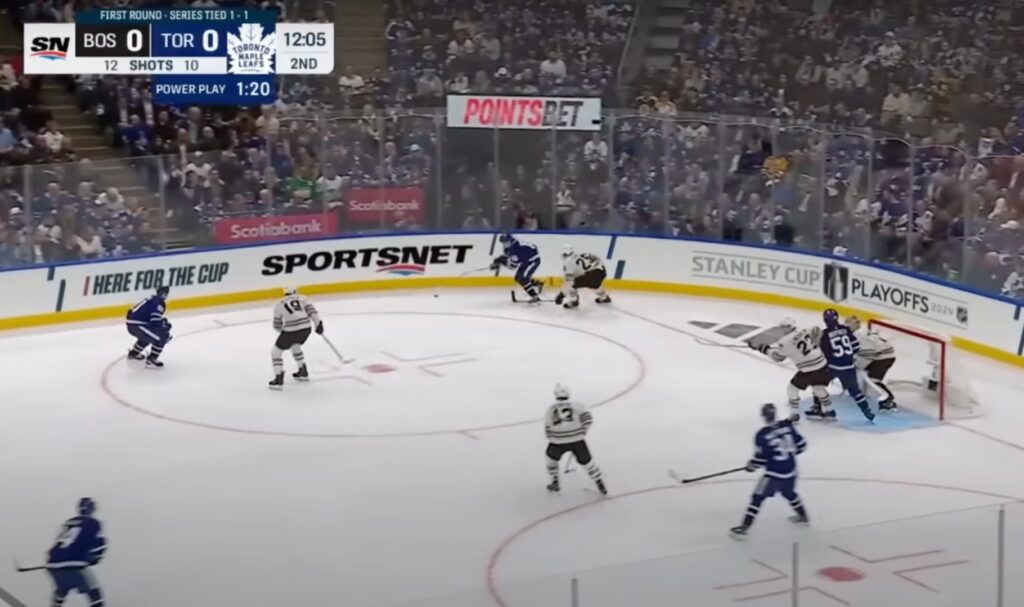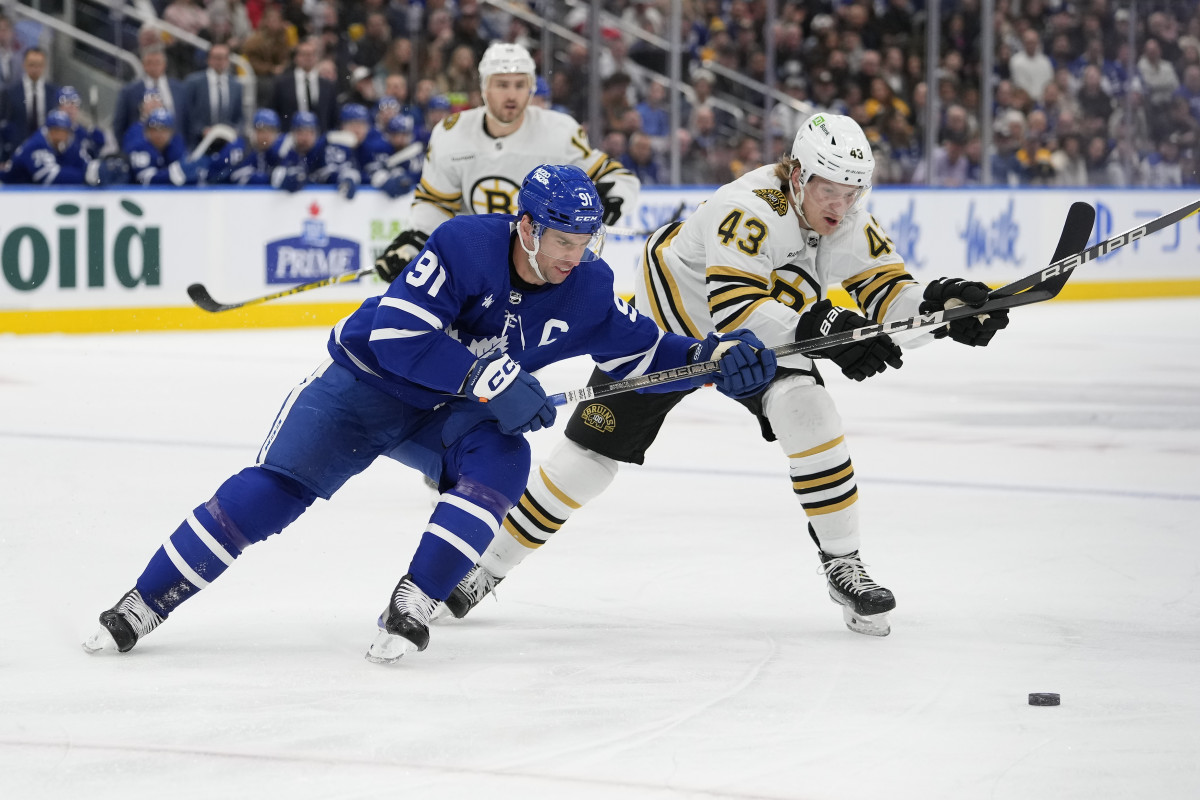After three playoff games, the Maple Leafs are down 2-1 in the series and face some lineup uncertainty around one of their best players, William Nylander. It’s not the ideal spot to be, but that’s the playoffs for you. It’s never easy, particularly when it comes to the Leafs and the postseason.
Now that we’ve hit a mini two-day break in the middle of the series, I wanted to take some time to collect my thoughts on the series.
First, let’s start with the positives.
At 5v5, the Leafs have generally controlled play. That was to be expected—the Bruins ranked 24th in 5v5 shot attempts this season. So far this series, the Leafs have controlled over 54 percent of the shot attempts. They’re carrying an advantage in both shot quantity and quality. All major statistical categories at five-on-five are around the 54-55 percent mark in favour of the Leafs.
I think those numbers are the byproduct of two main factors so far. The first is the Bruins do not possess a deep group. Their forwards have generally been unable to create or sustain pressure at 5v5. The Leafs have had some trouble breaking through the neutral zone at times, but when they do, they have been able to sustain pressure and cycle well. Toronto’s fourth line, in particular, has been able to hem the Bruins in their zone repeatedly to the point where Jim Montgomery flipped their line matchup.
Toronto should be encouraged by what’s happening at 5v5 and believe they can generally dictate the play. The Leafs‘ depth on a shift-by-shift basis has been difficult for the Bruins to handle, and Auston Matthews is clearly the best player in the series. While there are legitimate offensive concerns with the Tavares-Marner line, they have done a reasonably good job of defending the David Pastrnak line, which is their main task.
Hopefully, William Nylander’s return is imminent. With Nylander in the lineup, there is a clear path to creating very favourable matchups for the Maple Leafs.
In the meantime, the scoring simply hasn’t been there. Toronto’s special teams on both sides are in a whole separate category of bad, but the Bruins are actually outscoring the Leafs 6-5 at 5v5 so far in this season despite the Leafs holding a decided advantage in controlling play and generating chances. Some of this is due to the Leafs not finishing. Some of it is also the general disparity in net; the goal Ilya Samsonov allowed in Game 3 against Trent Frederic is the type of gift that the Leafs will not receive from the Bruins.
The Leafs’ defense is receiving a lot of attention, but the reality is that the team is averaging exactly two goals per game through three games. They cannot expect to win a best-of-seven series by collecting four 2-1 – or even 3-2 for that matter – victories. They need to score more. This team, in particular, is built to produce; they were second in the league in goals this season. They are designed to win games on the backs of their offense carrying the mail.
The Leafs are supposed to overcome defensive and goaltending deficiencies by scoring their way out of it. Instead, they are grinding through low-scoring games and struggling to get offensive contributions throughout their lineup. When the Bruins take even small leads, it feels insurmountable. That is the antithesis of the entire premise of the Leafs’ roster construction.
Brad Marchand’s six points are double the Leafs’ highest (Matthews and Domi have three each). Jake DeBrusk also has five points. The Leafs’ bottom six has one goal so far, compared to the Bruins’ bottom six with four (one was an empty netter). Charlie McAvoy’s three assists match the entire output of the Leafs’ defense so far.
It made me think back to the trade deadline when Chris Johnston reported at The Athletic, “Treliving reviewed last year’s playoff performance and determined it was goal scoring more than any other element that held the team back.” Treliving is, of course, correct in his assessment. The GM was right to seek more offense from a group that hasn’t even come close to scoring enough at playoff time.
Treliving’s two notable forward additions, Max Domi and Tyler Bertuzzi, have produced, to their credit. Domi is tied for the team lead in scoring, and Bertuzzi has two points in three games. The problem lies with the rest of the group, and the absence of Nylander and Bobby McMann compounds the issue.
There seems to be a lot of focus on defense and goaltending in the market. There are issues there – I’m certainly not going to deny it – and their special teams have also put them behind the eight-ball. But the margins should not be this thin, and their defense really shouldn’t be the focus. They aren’t Colorado getting lit up for seven goals in Game 1 against Winnipeg due to a lack of defense and goaltending, or the Oilers – Kings series where each team has scored at least four goals in both games so far. They are not scoring at a reasonable rate, and it’s magnifying any issue that arises defensively and/or in net.
It’s a broken record, but this isn’t a roster built on grinding out low-scoring games. It’s a roster built around what’s supposed to be a high-flying, high-scoring offense. Through three games, they aren’t even close, and that’s really where my focus lies at this point.
Notes

– Part of the Leafs’ offensive struggles are due to a power play that’s 1/11 through three games, including going 0/5 in G3 at home. They are not adjusting well to William Nylander’s absence, just as they did not adjust well to Mitch Marner’s absence in the regular season. Coincidentally, those are their two right-handed shots, and that’s why the coaching staff has tried to shoehorn Calle Jarnkrok into the top unit. The issue is that Jarnkrok is not exactly a big-time offensive producer and can’t do enough to facilitate playing alongside the Leafs’ top players in those situations.
The team’s one power-play goal came on a broken play, but notably, the play came from Auston Matthews on the right half wall instead of the left half wall, where the Leafs are generally trying to set up. With a full lineup, they run the power play on the left side through Nylander and Marner, and Matthews is the triggerman on the other side. At some point, if Nylander continues to miss games, they need to put the puck in their best player’s hands and let him figure it out.
The added benefit of running the power play through Matthews is that they can actually give him a left-handed shot to pass to down low (Max Domi would be my pick). The Bruins are aggressively pressuring the Leafs half-wall, and in fairness to Marner, he often doesn’t have options. He has Brandon Carlo, with his 6’5 frame and reach, aggressively pursuing him, and he’s struggling with it without any passing options. He’s forcing plays as a result.
The screenshot below is what it often looks like for Marner with the puck on the power play. Where is he supposed to go here?

– If you are going to go down on the power play, at least do it at the hands of your best player. Matthews has three shots on goal on the power play in three games over 11 power-play opportunities. That’s not good enough.
– The lack of a blue-line contribution also stands out regarding the team’s overall offensive struggles. Morgan Rielly, Ilya Lyubushkin, and Joel Edmundson each have an assist, while none of Timothy Liljegren, Jake McCabe, or Simon Benoit have a point yet. Liljegren doesn’t even have a shot on net yet in this series, while McCabe has one, which came in the first five minutes of Game 1. They are relying on both players to contribute offensively, and they haven’t come close to this point. McCabe, in particular, is coming off of a solid offensive season, scoring a career-high eight goals and 28 points. He tied for 46th among defensemen in even-strength points. They are counting on him for some level of offense.
– I am having a hard time understanding the penalty-killing deployment. The Leafs had a nine-game stretch before Marner returned when their penalty killing really started to round into form with a David Kampf–Connor Dewar first unit. Marner returned and was immediately placed back on the top penalty-killing unit, which went back to struggling. Marner has been on for 47% of the Leafs’ shorthanded minutes so far – the highest of any Leafs forward. One asset Dewar possesses over Marner is speed. He’s faster, so he can pressure players and pursue the puck aggressively. Instead, Dewar has been moved to the third unit. Presumably, they acquired Dewar in part to help with their penalty killing, and while he’s not an afterthought there, it’s a small role so far.
– This also increases Marner’s minutes as he’s averaging 2:18 per game shorthanded, contributing to his overall minutes in a series where he’s averaging 21:12 – far more ice time than the calibre of his play has dictated. He has one assist and four shots on net in three games. We can be honest about it. That’s nowhere near good enough to justify that much ice time.
– In fact, Marner is 11th among all forwards in the playoffs so far in terms of time on ice per game. They are forcing him onto various lines or offensive situations, and he’s playing huge minutes while putting up an assist in three games. Marner is taking a lot of heat for the lack of production, but the coaching staff gassing him with minutes is not helping the situation. His most productive month of the season, February, included the lowest average time on ice per game of any month this season. I don’t think it was a coincidence. He is better when he is a little fresher instead of playing massive minutes and needing to pace himself – to say nothing of any lingering issues from a reported high-ankle sprain, which is a difficult injury to return from.
– On the bright side, young and inexperienced players like Pontus Holmberg, Nick Robertson, and Matthew Knies have not looked out of place in these playoffs, even if the production isn’t there. That might not help them win this season specifically—here is your reminder that teams do not generally win with a bunch of young players in their playoff lineup—but all three have shown encouraging flashes. Holmberg showing well at center is a positive development for the organization moving forward.
– The Matthews line has also been good; they’ve been able to attack shift after shift for long stretches of each game. Their chemistry is evident, as all three players know their roles: Bertuzzi goes to the net, Domi is the playmaker, and Matthews is the scorer. They are up in their minutes 3-1 as a line at 5v5. The rest of the team is losing their minutes 5-3.
– The fourth line has also been good, winning every underlying category across the board and tied 1-1 in goals. There is a lesson to be learned from their success. They play simple playoff hockey, getting the puck in deep and forechecking. They are physical. They cycle the puck. They throw pucks on net. They go to the net. It wears down the Bruins’ defense, and it also helps the overall team get through the neutral zone when the Bruins are clogging it right up to make life difficult on the Leafs’ skilled forwards.
– The Bruins responded by loading up their top six on the road, moving DeBrusk up to the top line in place of Heinen and Geekie (who I’d rate as their sixth-best forward overall) onto the Pastrnak line. On the whole, the Bruins shook up three lines and two defense pairings. It’s a lot of change, and Game 3 was their best game territorially against the Leafs.
I’m very curious how – if at all – Keefe adjusts to this with his lines. He might be forced to make changes if Nylander returns. If not, will he run the same lines and defense pairings yet again? I would strongly consider moving Jarnkrok up to the matchup line and loading up fire vs. fire if Nylander is out again. Jarnkrok is built for that type of checking role, and he owns a good enough shot to finish chances when they come.
ICYMI: New MLHS Playoff Podcast
In the latest episode of the MLHS Podcast, Nick Ashbourne, Anthony Petrielli, and Alec Brownscombe discuss the first three games of the Boston-Toronto series, including where the Leafs have fallen short so far, Marner’s play, Nylander’s absence, the special teams crisis, and reasons for optimism ahead of Game 4.

































